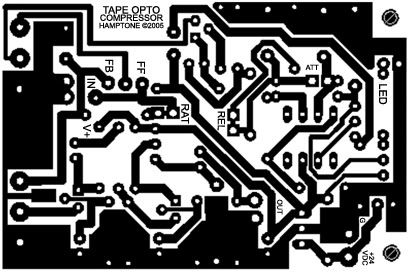[quote author="DrFrankencopter"]The opto sidechain I was reffering to is
this one
It's a little different than the one that Scott Hampton designed. You'dd see in the sidechain schematic that changing the ratio pot inserts a series resistance that acts to limit the amount of current going to the LED. The rectified, thresholded compared, and timed signal is a voltage proportional to the amount 'over' threshold the input is, and the ratio control determines the degree of compression by altering the amount of current sent to the vactol's LED.
[/quote]
Dr. F,
But this side chain is not for FF opto compressor, but a FB opto compressor. Actually, it's a FB with some FF summed in, similar to the LA2A side chain when operating in "compress". The circuit will act like a FF circuit until the opto is of a low enough resistance to begin to reduce the gain to the side chain, via the attenator formed by the series resistor R43, and shunt resistance formed by the series connection of R44 and the opto.
Changing the LED current in this circuit will change the ultimate ratio of the circuit. Now, if you changed the side chain take off point prior to the 4.99kohm resistor R43, as opposed to between the R43 and R44 a 1kohm, then changing the LED current would not change the ratio, as it would be a pure FF circuit. It would merely change the rotation point of when compression would reach infinity to one ratio.
If you had an opto that had a log transfer curve, such that a decade decrease in reistance was proportional to a linear change in diode current (lets say 1ma for a change from 100k to 10k, and another 1ma for a change from 10k to 1k, etc) then, if you changed the current in the LED vs input to the side chain (or changed the gain of the side chain), you could control the ratio in a FF circuit. You would need a dc to log converter in the side chain, to make that circuit work.
However, these devices are (roughly) purely linear in tranference, in that a decade change in resistance in the cell is proportional to a decade change in LED current. There is no way you could design a FF circuit with this kind of element that would allow you to adjust the compression ratio by varying the current through the LED by changing gain of the side chain.
jD



